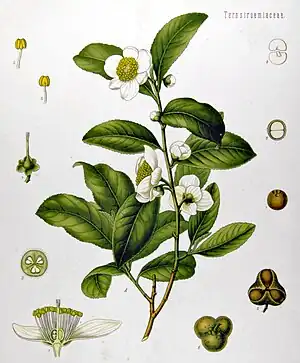Sinecatechins
 Sinecatechins is an extract from the leaves of Camellia sinensis. | |
| Names | |
|---|---|
| Trade names | Veregen, Polyphenon E |
| Clinical data | |
| Main uses | Genital warts[1] |
| Side effects | Burning, itchiness, swelling, redness at the site of use[1] |
| WHO AWaRe | UnlinkedWikibase error: ⧼unlinkedwikibase-error-statements-entity-not-set⧽ |
| Pregnancy category |
|
| External links | |
| AHFS/Drugs.com | Monograph |
Sinecatechins, sold under the trade name Veregen, is a medication used to treat external genital warts.[1] It is applied to the affected area.[1] This can be done by the person themselves.[2]
Common side effects include burning, itchiness, swelling, and redness at the site of use.[1] Other side effects may include phimosis, enlarged lymph nodes, burning with urination, and reactivation of genital herpes.[2] How it works is not known.[2]
Sinecatechins was approved for medical use in the United States in 2006.[1] In the United States it costs about 1,400 USD for a tube as of 2021.[3] It was the first botanical drug approved in the USA and is made from green tea leaves.[2]
Medical uses
It is used to treat external genital warts.[4][2][5]
Dosage
The 15% solution is applied three times per day to the affected area.[1] Treatment may last for 16 weeks.[2]
Manufacture
It is a specific water extract of green tea leaves from Camellia sinensis. Sinecatechins are mostly catechins, 55% of which is epigallocatechin gallate.[6]
References
- 1 2 3 4 5 6 7 "Sinecatechins Monograph for Professionals". Drugs.com. Archived from the original on 4 March 2021. Retrieved 12 October 2021.
- 1 2 3 4 5 6 7 Masters KP (2009). "New Drug Reviews: Sinecatechins (Veregen) for External Genital and Perianal Warts". Am Fam Physician. 80 (12): 1447–1454. Archived from the original on 2021-03-07. Retrieved 2021-03-17.
- ↑ "Veregen Prices, Coupons & Patient Assistance Programs". Drugs.com. Archived from the original on 26 February 2021. Retrieved 12 October 2021.
- ↑ "Veregen label information" (PDF). Archived (PDF) from the original on 2016-02-01. Retrieved 2015-05-02.
- ↑ Fürst R, Zündorf I (2014). "Plant-derived anti-inflammatory compounds: hopes and disappointments regarding the translation of preclinical knowledge into clinical progress". Mediators Inflamm. 2014: 146832. doi:10.1155/2014/146832. PMC 4060065. PMID 24987194.
- ↑ Mayeaux EJ, Dunton C (July 2008). "Modern management of external genital warts". J Low Genit Tract Dis. 12 (3): 185–192. doi:10.1097/LGT.0b013e31815dd4b4. PMID 18596459. S2CID 33302840.